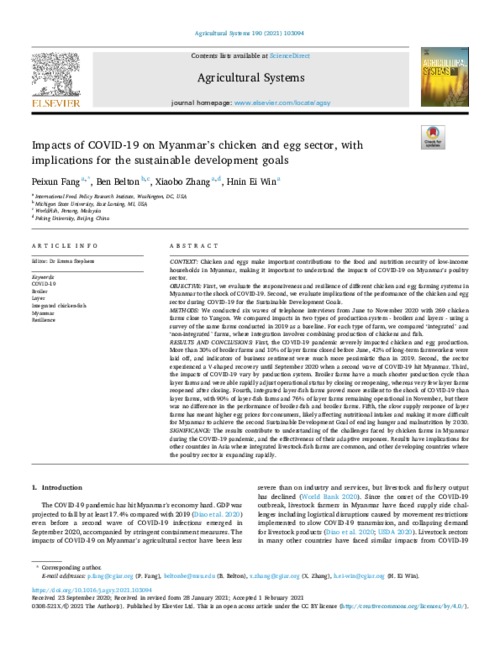Impacts of COVID-19 on Myanmar’s chicken and egg sector, with implications for the sustainable development goals

Chicken and eggs make important contributions to the food and nutrition security of low-income households in Myanmar, making it important to understand the impacts of COVID-19 on Myanmar’s poultry sector. First, we evaluate the responsiveness and resilience of different chicken and egg farming systems in Myanmar to the shock of COVID-19. Second, we evaluate implications of the performance of the chicken and egg sector during COVID-19 for the Sustainable Development Goals. We conducted six waves of telephone interviews from June to November 2020 with 269 chicken farms close to Yangon. We compared impacts in two types of production system - broilers and layers - using a survey of the same farms conducted in 2019 as a baseline. For each type of farm, we compared ‘integrated’ and ‘non-integrated’ farms, where integration involves combining production of chickens and fish. RESULTS AND CONCLUSIONS: First, the COVID-19 pandemic severely impacted chicken and egg production. More than 30% of broiler farms and 10% of layer farms closed before June, 42% of long-term farmworkers were laid off, and indicators of business sentiment were much more pessimistic than in 2019. Second, the sector experienced a V-shaped recovery until September 2020 when a second wave of COVID-19 hit Myanmar. Third, the impacts of COVID-19 vary by production system. Broiler farms have a much shorter production cycle than layer farms and were able rapidly adjust operational status by closing or reopening, whereas very few layer farms reopened after closing. Fourth, integrated layer-fish farms proved more resilient to the shock of COVID-19 than layer farms, with 90% of layer-fish farms and 76% of layer farms remaining operational in November, but there was no difference in the performance of broiler-fish and broiler farms. Fifth, the slow supply response of layer farms has meant higher egg prices for consumers, likely affecting nutritional intakes and making it more difficult for Myanmar to achieve the second Sustainable Development Goal of ending hunger and malnutrition by 2030. The results contribute to understanding of the challenges faced by chicken farms in Myanmar during the COVID-19 pandemic, and the effectiveness of their adaptive responses. Results have implications for other countries in Asia where integrated livestock-fish farms are common, and other developing countries where the poultry sector is expanding rapidly.
Permalink
Date Available
Type
Publisher
Countries
ISSN
0308-521X
Copyright
CC-BY-NC-4.0
Language